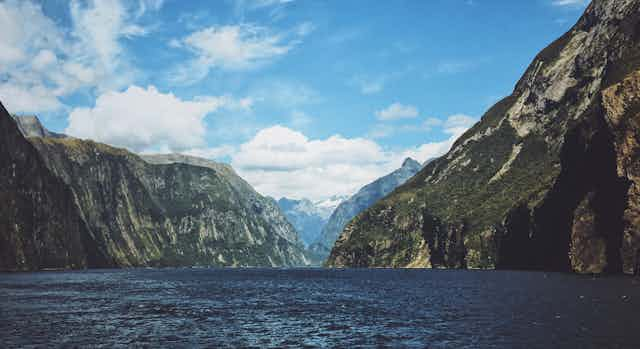This is an article from Curious Kids, a series for children. The Conversation is asking kids to send in questions they’d like an expert to answer. All questions are welcome – serious, weird or wacky! You might also like the podcast Imagine This, a co-production between ABC KIDS listen and The Conversation, based on Curious Kids.
How do mountains get made? - Astrid, age 6, Marrickville
Hello Astrid. You may not believe this but when I was about your age my teacher (Mr Rouve) explained to the class how mountains get made.
He took a sheet of paper and put it flat on the table. Then, he put the tips of his right and left hands’ fingers on each side of the flat sheet and slowly moved his hands toward each other. Try to do it and you will see that the middle part of the paper will lift off the table to form a nice fold.
My teacher explained that mountains form in a similar way, when flat layers of rocks are pushed toward each other they move upward forming tall mountains.
My teacher was really excited by a discovery made by geologists at that time, when I was a kid. These geologists had figured out that the surface of the Earth was, like a giant jigsaw puzzle, made of pieces. Those pieces, called “tectonic plates”, move and bump into each other.
This bumping creates earthquakes, which slowly push the ground surface upward to make mountains. It happens so slowly that, in fact, you are getting taller faster than mountains do, except mountains keep growing and growing and growing for many millions of years until they are so heavy they can no longer grow taller, only wider.
In fact, Australia and New Zealand are sitting on two different “tectonic plates” that move towards each other at the speed of a few centimetres per year. Where they bump into each other, the ground gets lifted to form the stunning New Zealand Alps, the top of which stands close to 4,000 metres. Can you imagine about 4,000 people as tall as you, standing straight up on each other shoulders? That’s how tall these mountains are.

Mountains also form when the Earth’s crust is pushed upward from underneath. At the same time the New Zealand Alps started to form, a large hot bubble of rocks raising from deep in the Earth, like a giant air balloon, was pushing upward the surface of the eastern part of Africa forming a 4,000 metre high plateau. This plateau split to form what is known as the East African Rift, a valley twice as long as the New Zealands Alps.
There are many mountains at the surface of the Earth. Some we can see, some we can’t because they are under the sea. If you could take a submarine and dive under the sea, for instance in the ocean in between Australia and Antarctica, you could visit a long mountain where the Australian and Antarctica tectonic plates move away from each other.
Thank you again for your fantastic question.
Read more: Curious Kids: What existed before the Big Bang? Did something have to be there to go boom?
Hello, curious kids! Have you got a question you’d like an expert to answer? Ask an adult to send your question to curiouskids@theconversation.edu.au

Please tell us your name, age and which city you live in. We won’t be able to answer every question but we will do our best.

